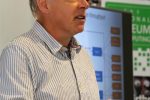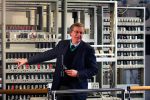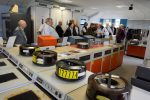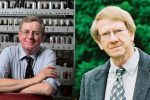Life working with one of the world’s first general purpose computers was brought vividly to life when EDSAC veterans visited The National Museum of Computing to see the latest stage of the reconstruction of the 1950’s Cambridge University computer.
The original computer was the first to enter service at a University and transformed research methods, contributing to at least three Nobel prizes. The historic machine is currently being reconstructed at The National Museum of Computing on Bletchley Park and is expected to be operational in 2017, almost seven decades after the original machine ran its first program.
The visiting EDSAC veterans – Joyce Wheeler, then an astronomy postgraduate student, and Margaret Marrs, an EDSAC operator – were very impressed at the authenticity of the reconstruction and gave the current EDSAC team valuable details about how they used it. They were joined by Liz Howe, an operator of EDSAC 2, who was able to speak of the people who worked in the Cambridge Mathematical Laboratory including staff and users.
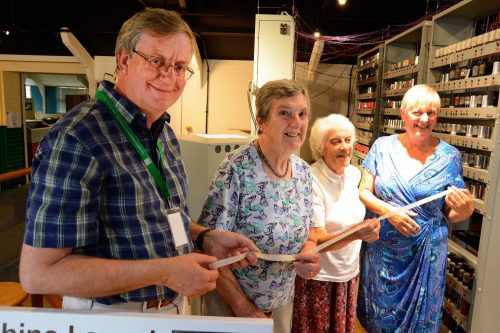
Andrew Herbert, leader of the EDSAC Project, said: “In reconstructing EDSAC, photographs and some documentation have been available, but it has been essential for the team to get into the mindset of the original creators to be able to fill in many unrecorded details. Thankfully the EDSAC veterans have confirmed that the guesses that we’ve had to make have been correct.”
“The most fascinating aspect of their recollections is the social history of day-to-day working with an early computer. Strikingly, many women were computer operators and users back then, a balance that today’s computing industry is striving to re-establish. Working boundaries were obviously much more flexible then and we learned how the engineers worked very closely with the operators and users. But it was certainly tough for the first programmers — they really were thrown in at the deep end and had to teach themselves the new skill of programming.”
Researcher and programmer Joyce Wheeler recalled: “There were notes describing EDSAC and I remember going to the lab to read it all through and to do the exercises at the back. They were very important in learning how to program!”
As the EDSAC project nears completion, the focus is starting to shift from hardware to software. In many respects, coding EDSAC marks the beginning of professional programming and the team was fascinated to learn about many nearly forgotten characters who pioneered software development with EDSAC.
Joyce Wheeler remembered: “My husband, David Wheeler, and research student Geoff Cook had set up the machine to seek prime numbers when the engineers wanted to run something. They would always use their prime numbers program during quiet periods and each time it would re-start where it had left off.” That began a tradition of seeking primes that continued through to Titan (effectively EDSAC 3) and even to this day.
Impressed by the reconstruction team’s work, Margaret Marrs had a gleam in her eye when she made her one criticism: “It’s much too clean!” She was also able to confirm that the original EDSAC did have a loudspeaker and, nearly seven decades on, was able to give an imitation of how it sounded.
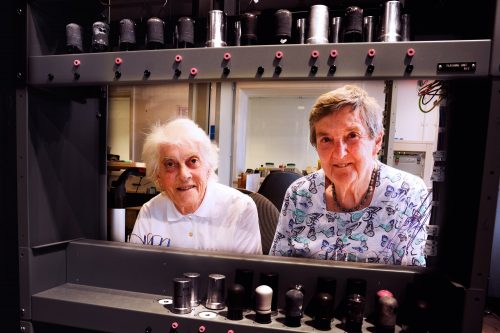
The EDSAC Project is expected to be completed in 2017 and there are plans to enable students on the Museum’s Education programme to bring their prepared and debugged programmes which will be punched as EDSAC paper tapes and run on the machine.
The ongoing reconstruction can be seen by visitors to the Museum during public opening hours: www.tnmoc.org/visit
The full story of the EDSAC Project can be seen in text and video at www.edsac.org
EDSAC, the Electronic Delay Storage Automatic Calculator, was built immediately after World War II by a team led by Sir Maurice Wilkes in the Mathematical Laboratory of the University of Cambridge. It was one of the first practical general purpose computers and was used by scientific researchers across the University. The EDSAC design was later developed to create LEO, the world’s first business computer.
About EDSAC
- EDSAC was based on the ideas of John von Neumann and others who in 1945 suggested that the future of computing lay in computers which could store sets of instructions (programs) as well as data in a memory.
- EDSAC was over two metres high and occupied a ground area of four metres by five metres.
- Pre-dating the transistor, its 3000+ thermionic valves / vacuum tubes used as logic were arranged on 12 racks containing just over 140 chassis in total.
- Mercury-filled tubes were used for the main memory, comprising 512 words initially, later 1024 word (equivalent to 2KB/4KB of PC storage).
- It performed 650 instructions per second, effectively computing more than 1500 times faster than the mechanical calculators it replaced.
- EDSAC read in programs from paper tape and printed its results on a teleprinter.
- EDSAC ran its first program on 6 May 1949 and soon after that began nine years of regular service for scientific users across the University of Cambridge and other institutions, ending in July 1958 when it was dismantled to enable the re-use of precious space. By then it had been superseded by the faster and much larger EDSAC 2.








